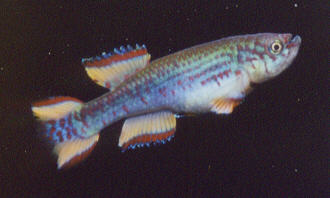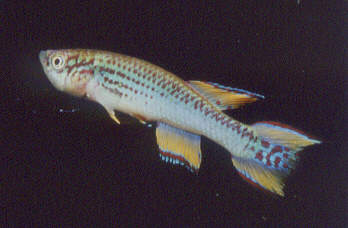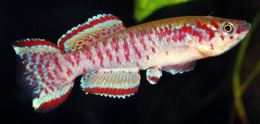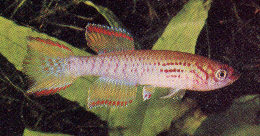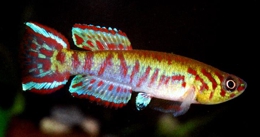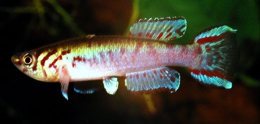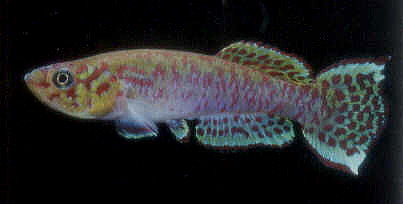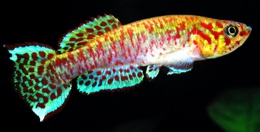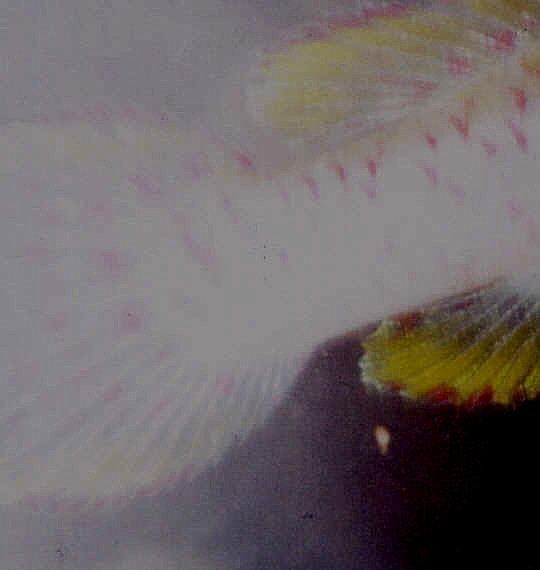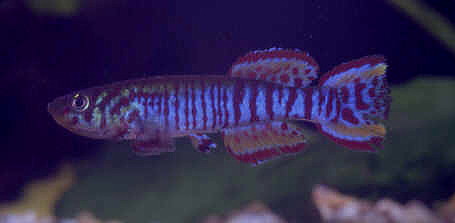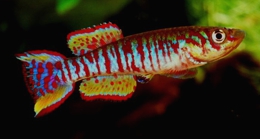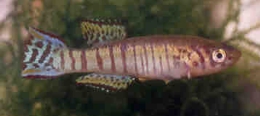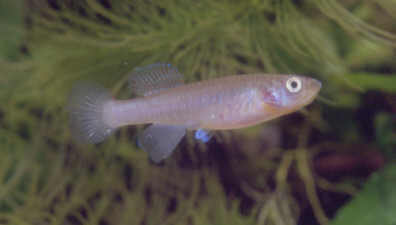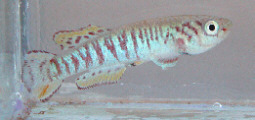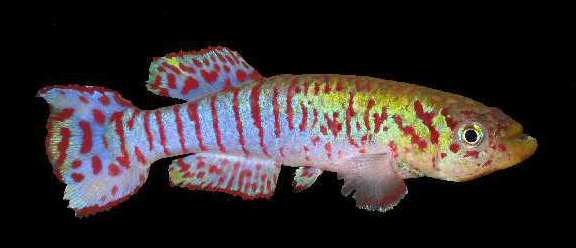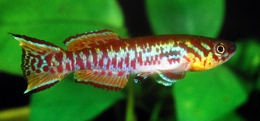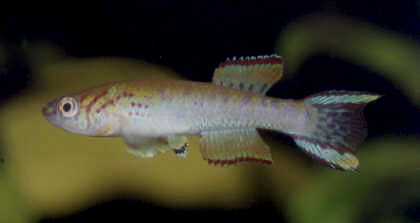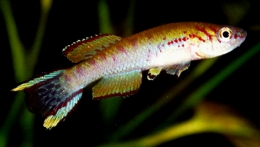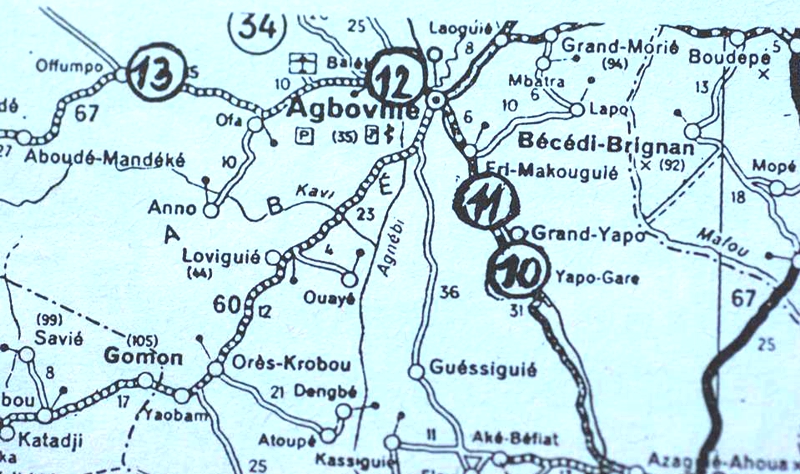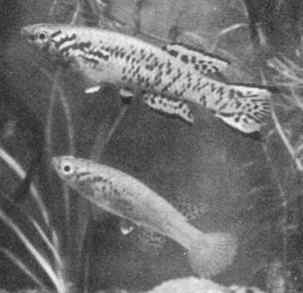Fundulopanchax walkeri (Boulenger 1911)

GH 2 / 74
Photo courtesy of Ed Pürzl
| Meaning of Name |
After the collector R.B.H.Walker. |
|||||||||||||||||||||||||||||||||||||||||||||||||
| First Description |
Boulenger G.A. 1911. (Fundulus walkeri). Descriptions of new African Cyprinodont fishes. Annals & Magazine of Natural History (8) 8 (44): p 262. |
|||||||||||||||||||||||||||||||||||||||||||||||||
| Size |
6 cm |
|||||||||||||||||||||||||||||||||||||||||||||||||
| Meristics |
|
|||||||||||||||||||||||||||||||||||||||||||||||||
| Karyotype |
|
|||||||||||||||||||||||||||||||||||||||||||||||||
| Sub-Genus |
Paraphyosemion |
|||||||||||||||||||||||||||||||||||||||||||||||||
| Group |
gardneri |
|||||||||||||||||||||||||||||||||||||||||||||||||
| Synonyms |
|
|||||||||||||||||||||||||||||||||||||||||||||||||
|
Populations
|
Abidjan - Article reference - Foersch. W. 1971. Aphyosemion walkeri Boulenger 1911. DATZ 24 (7):218-221.
Agboville - Known
to have been distributed in the BKA in May 1979. Radda collected around
this town in 1977 & used the reference - Location 12.
Akwatia - Collected
by T.Stuart McClure in 1963 & sent to John Gonzales & Bruce
Turner in the USA. Turner sent specimens to Scheel. Awasi - Bibianaha - Bokitsa Mine - Thought
to have been a gold mine. This was closed down in 1920 & has been
difficult to locate by collectors. Bouaké - Collected
by G.Schmitt in 1977.
Eri Makouguié - Collected by Radda in 1977, Loc. 11, Eri Makoguié 7 km south of Agboville on the road to Abidjan.
Grand Yapo - Collected
by Radda in 1977. Location 10, Yapo, 20 km south of Agboville on the
road to Abidjan.
Kumasi - First collected
by Gerald Schreiber in 1974 & coded GH 1 / 74.
Kutunse - Same location
as GH 2 / 74. This code was always used but for some reason it was
dropped by hobbyists in favour of Kutunse & is seen as such today
in many cases.
Kutunse
being circulated in the USA taken in November 2005. This male reported
to be 3" long. Lamto - Mpraeso - Offumpo - Collected by Radda, Loc. 13, Ofumbo, 28 km west of Agboville on the road to Tassale.
Radda's Location 9 - Collected in 1977 south of Grand Yapo. This location is not shown on his map below.
Yamoussokro -
|
|||||||||||||||||||||||||||||||||||||||||||||||||
| Type Locality |
Bokitsa Mine near Wasa, southwestern Ghana. |
|||||||||||||||||||||||||||||||||||||||||||||||||
| Distribution |
The Bia, Tano, Ankobra & Oda River systems of southwestern Ghana & the Bandama, Comoe & Bia River systems in central, south & eastern Ivory Coast. |
|||||||||||||||||||||||||||||||||||||||||||||||||
| Habitat |
Coastal humid rainforest & forested savannah
biotopes. Found in streams, pools & swamps. They are not considered
to be an abundant sp. in the wild. |
|||||||||||||||||||||||||||||||||||||||||||||||||
| Distinguishing Characteristics | ||||||||||||||||||||||||||||||||||||||||||||||||||
| Colour/Pattern Variability | High | |||||||||||||||||||||||||||||||||||||||||||||||||
| History |
Scheel in ROTOW 1 p 416 reported that the description of walkeri was based on 3 specimens (probably females) collected at Bokitsa Mine, Wasa, Ghana by R.B.N.Walker. These are reported as being badly preserved & brown all over. Boulenger gives the following collectors / locations in his 1915 Catalogue.
Collected by L.Sheljuzhko in 1952 or 1953 (conflicting articles) in a pond, formed by a creek which ran out of impenetrable jungle at a location 85 km north of Abidjan towards Agboville. The water was very clear & he considered it may have been fed by a spring. He also found walkeri in surrounding ponds, creeks & ditches. All males from the first 2 collecting trips were packed in water from the biotope but all died in transit. Females too did little better & only a few reached there destination alive. He returned to the site & collected more males which were packed in local aged water. These fish were fed rare scrapped beef & arrived in good shape in Munich (AKA Journal December 1971). Foersch raised about 500 young. This population was said to resemble what we know of as the 'orange' strain circulating in the '80's. These were sent to Werner in Munich, Germany. An aquarium strain was established & they were known to have been distributed in Europe & the USA. They were reportedly soon to become extinct in captivity. This strain was known as 'Boulenger's gardneri'.
In 1963 J.Arnoult collected a similar looking fish from the Agnebi River system, 85 km north of Abidjan, southeastern Ivory Coast. These were taken back to France. Bruce Turner received live fish from a contact in Ghana at this time & walkeri was again received in the USA. Both strains were reportedly similar. Scheel considered these to be identical with spurelli as written up by Boulenger in 1913. First reports of there introduction into the UK comes in BKA Killi-News No.7 (March 1966) where, on the 17th January of the same year the then A.spurelli was brought over from a visiting German aquarist (unnamed). The sp. was regarded as not being in the country prior to this date. These fish were put into the NSPC (New Species Propagating Committee). Other sp. received from this contact included the then named A.cinnamomeum, A.'burundi' & Cyn.ladigesi. On the 10th July 1970 the BKA received an import from David Blair in Ghana containing a few pairs of walkeri but no population name was given. In 1974 Gerhard Schreiber collected the species near Kutunse & coded them GH 2 / 74. What is not generally known is that he also caught them at Kumasi & gave them the code GH 1 / 74. This code is shared by E.chaperi schreiberi although they were not taken out of the same collection point (personal comments Ed Pürzl / Gerhard Schreiber). Radda collected this species in the Ivory Coast in December 1977 Ed Pürzl searched the Bokitsa Mine area in March 1978 but found no Fp.walkeri as this time of year is the dry season in this area. History of the synonym Fundulus spurelli Boulenger 1913 Boulenger described this
sp. in 1913 from 3 ( ? ) specimens collected by Dr.H.G.F.Spurrell in
the Tano River, Gold Coast ( Scheel quotes 3 specimens in ROTOW
1 p 415 although Boulenger's
Boulenger gives the following collectors / locations in his 1915 Catalogue.
History of the synonym Aphyosemion litoriseboris Radda 1976 Described as Aphyosemion litoriseboris spec. nov. in a technical paper in the Journal of the AKA 20. p.301-305 by A.C.Radda November 1976. |
|||||||||||||||||||||||||||||||||||||||||||||||||
| Breeding Notes |
Regarded as an easy species to breed. Bottom mops can be used as a spawning medium along with peat or sand. Eggs can be dry stored & have a dry incubation time of about 2-3 months. Water incubated eggs take about 3 weeks to hatch. Fry are capable of taking newly hatched brine shrimp eggs as a first food. Growth rate is fast with sexual maturity taking around 2 months. A breeding report can be found in BKA newsletter
No.81, May 1972. The breeder kept the pair in an 18 x 10 x 10"
tank at 68-72°F, pH 6·8, German hardness 3-4°. A layer
of peat fibre was used on the tank base for the pair to spawn in. They
layed 25-30 eggs daily into this medium. The fish were seperated after
10 days of spawning. Foersch wrote a breeding report in the AKA Journal
of December 1971 where he kept his fish in soft to medium hard water
at a temperature between 68-74°F. He found that if maintained at
higher temperatures they became susceptible to disease & aged faster.
Mops were used for a spawning medium & he collected 100 eggs per
pair daily. In a 3 week period he collected 613 eggs from a single pair.
Females in good condition were capable of laying 40-50 eggs in the period
of 2-3 hours. Huber (BKA newsletter No.210, February 1983) reported that adult size of 7cm can be reached in less than 6 months. This article is quite comprehensive on this sp. |
|||||||||||||||||||||||||||||||||||||||||||||||||
| Diameter of Egg | 1·1mm - 1·3mm. | |||||||||||||||||||||||||||||||||||||||||||||||||
| Remarks |
The GH2 / 74 collection site is reported to have been buried under a local market. |
